北师大版(2019)选择性必修第二册Unit 4 Humour Lesson 1 What's So Funny课件 (共38张PPT)
文档属性
| 名称 | 北师大版(2019)选择性必修第二册Unit 4 Humour Lesson 1 What's So Funny课件 (共38张PPT) | 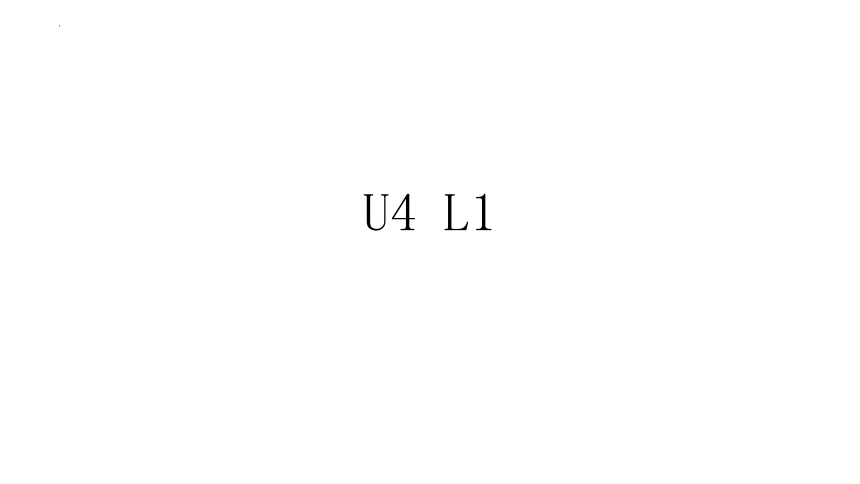 | |
| 格式 | pptx | ||
| 文件大小 | 3.3MB | ||
| 资源类型 | 教案 | ||
| 版本资源 | 北师大版(2019) | ||
| 科目 | 英语 | ||
| 更新时间 | 2023-11-27 10:28:48 | ||
图片预览


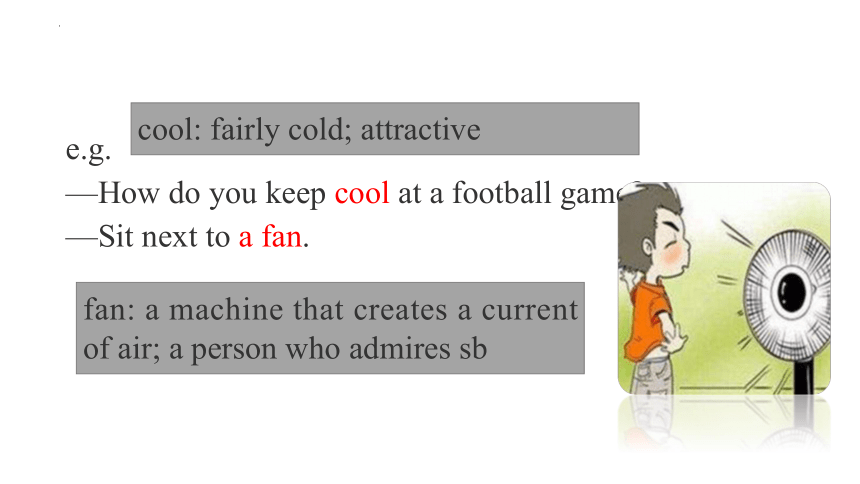
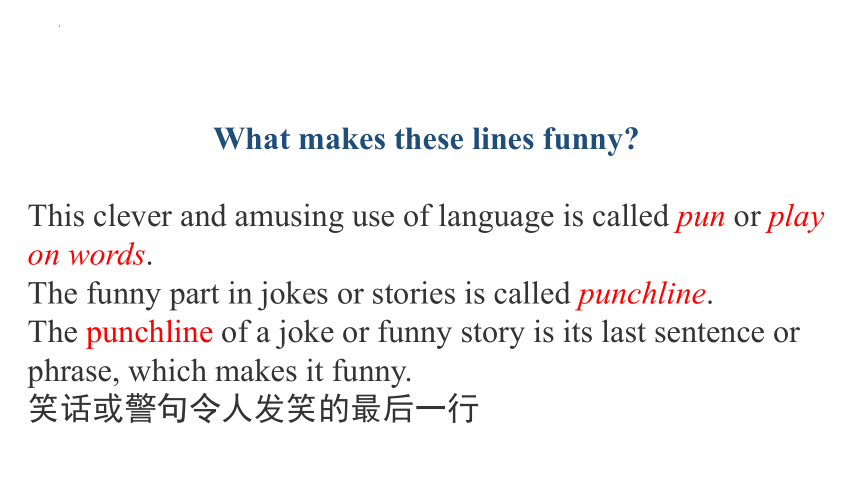
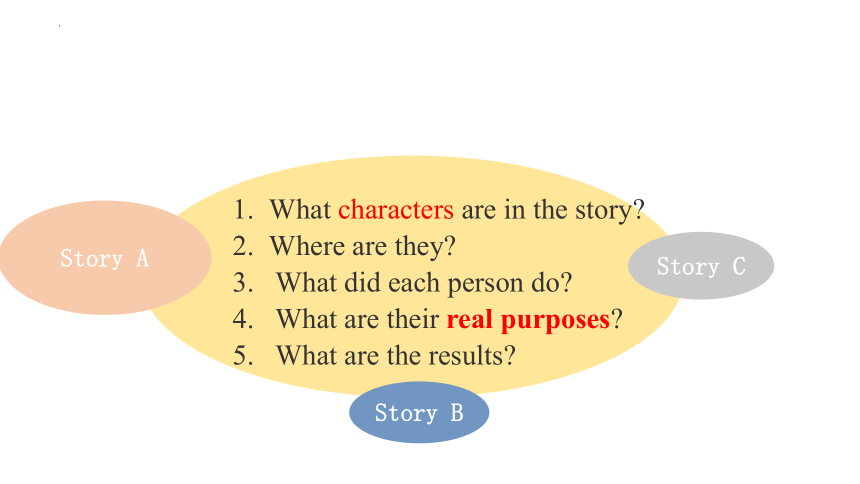

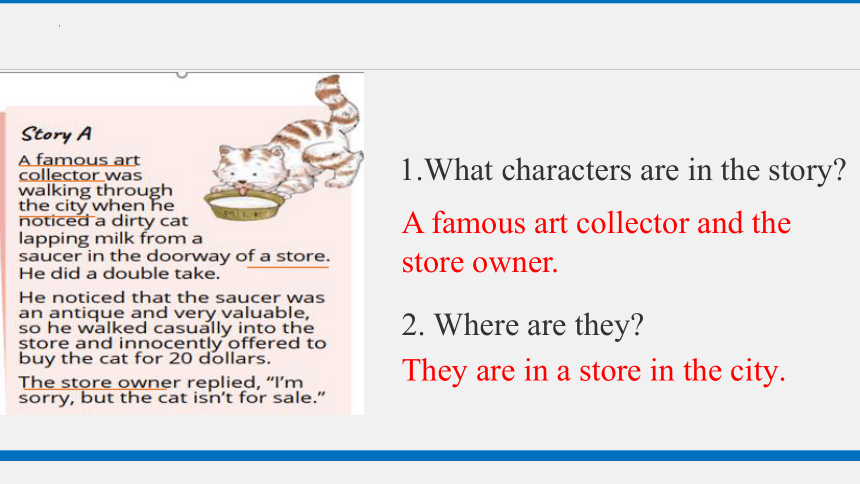
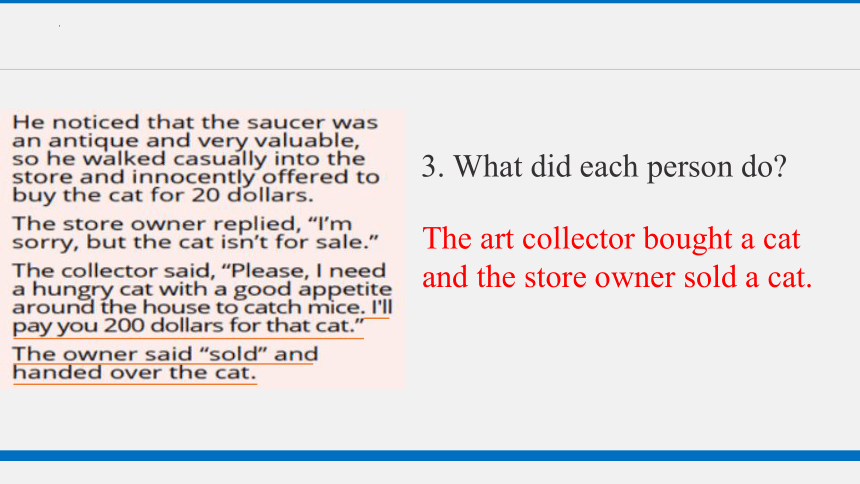
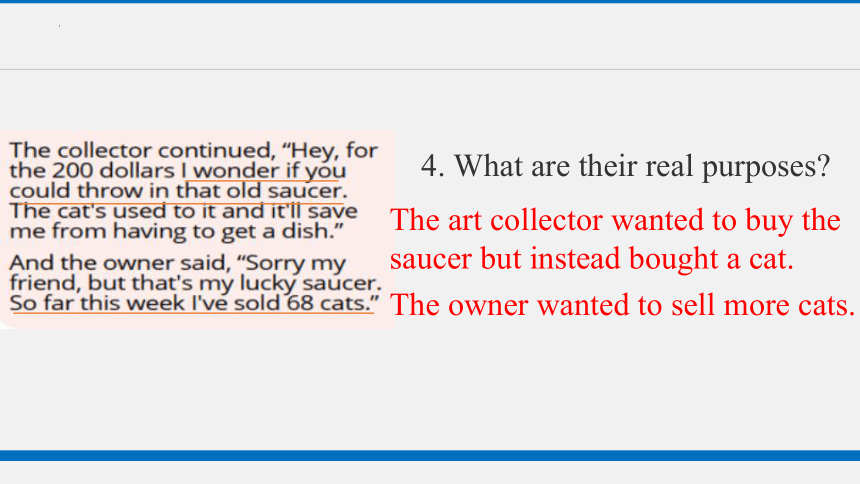
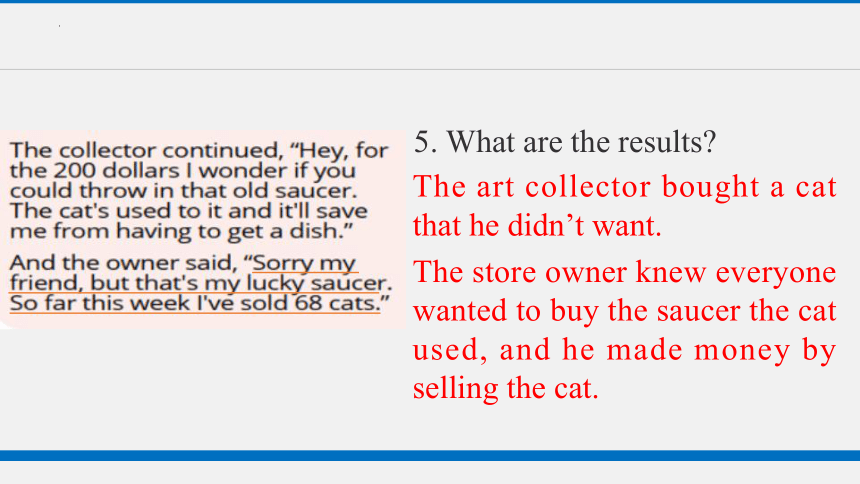
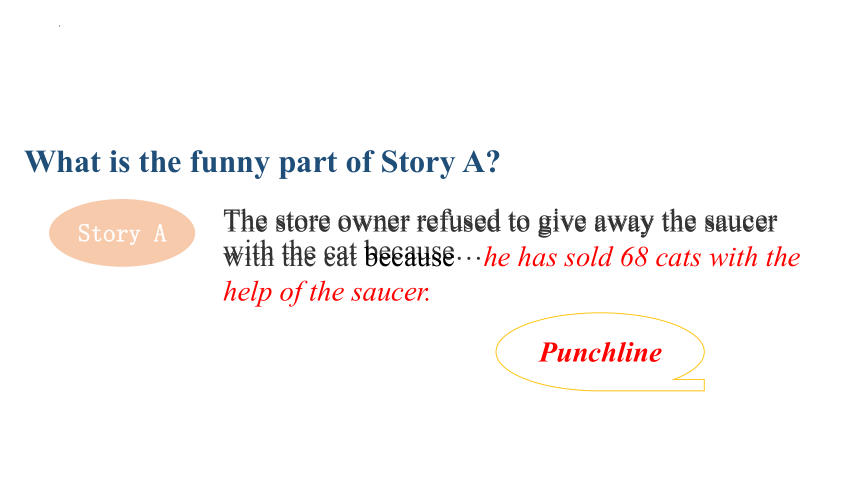
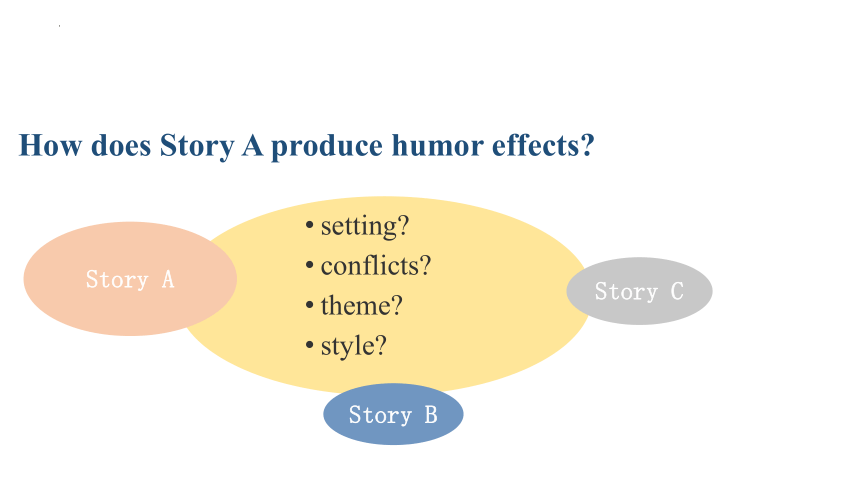
文档简介
(共38张PPT)
U4 L1
e.g. A bicycle can’t stand on its own because it is two-tyred.
Activate and Share
too tired
e.g.
—How do you keep cool at a football game
—Sit next to a fan.
Activate and Share
cool: fairly cold; attractive
fan: a machine that creates a current of air; a person who admires sb
Activate and Share
This clever and amusing use of language is called pun or play on words.
The funny part in jokes or stories is called punchline.
The punchline of a joke or funny story is its last sentence or phrase, which makes it funny.
笑话或警句令人发笑的最后一行
What makes these lines funny
What characters are in the story
Where are they
3. What did each person do
4. What are their real purposes
5. What are the results
Read and Explore
Story A
Story B
Story C
Story A
What characters are in the story
Where are they
3. What did each person do
4. What are their real purposes
5. What are the results
1.What characters are in the story
A famous art collector and the store owner.
2. Where are they
They are in a store in the city.
3. What did each person do
The art collector bought a cat and the store owner sold a cat.
4. What are their real purposes
The art collector wanted to buy the saucer but instead bought a cat.
The owner wanted to sell more cats.
5. What are the results
The art collector bought a cat that he didn’t want.
The store owner knew everyone wanted to buy the saucer the cat used, and he made money by selling the cat.
The store owner refused to give away the saucer with the cat because…
Read and Explore
Story A
What is the funny part of Story A
The store owner refused to give away the saucer with the cat because he has sold 68 cats with the help of the saucer.
Punchline
setting
conflicts
theme
style
Read and Explore
How does Story A produce humor effects
Story A
Story B
Story C
Story A
setting
conflicts
Theme: one would suffer from his own wisdom if he wants to take unfair advantage.
(sarcasm)
setting
conflicts
theme
style
Light & Relaxing
What characters are in the story
Where are they
3. What did each person do
4. What are their real purposes
5. What are the results
1.What characters are in the story
Sherlock Holmes and Dr. Watson.
2. Where are they
They are outdoors.
Sherlock woke up and asked Watson what he saw.
Watson spoke about astronomy and the stars he saw.
3. What did each person do
Sherlock wanted to confirm their tent had been stolen.
Watson spoke about astronomy, the position of stars, the scientific measurement of time and the atmosphere.
4. What are their real purposes
Sherlock realized the tent had been stolen, but Watson didn’t realize they could see the stars because their tent had been stolen.
5. What are the results
What characters are in the story
Where are they
3. What did each person do
4. What are their real purposes
5. What are the results
1.What characters are in the story
A doctor and a clown.
2. Where are they
They are in the doctor’s surgery.
The middle-aged man told the doctor that he was feeling down.
The doctors asked the man some questions.
3. What did each person do
The man wanted to see how he could feel better.
The doctor wanted to figure out what went wrong.
4. What are their real purposes
The clown who makes everyone laugh can’t cheer himself up.
The doctor suggested the man should go to see the performance by the clown.
5. What are the results
Read and Explore
Story B
Story C
Sherlock Holmes and Dr. Watson saw millions of stars at night because…
An amazing clown couldn’t…
What are the funny parts in Story B and C
Sherlock Holmes and Dr. Watson saw millions of stars at night because their tent had been stolen.
An amazing clown couldn’t cheer himself up.
setting
conflicts
theme
style
Read and Explore
How do Story B and C produce humor effects
Story A
Story B
Story C
setting
conflicts
Too complicated methods cannot solve easy problems. (sarcasm)
setting
conflicts
theme
style
Light & Relaxing
setting
conflicts
People who please others all the time suffer from depression.
(warning)
setting
conflicts
theme
style
Serious & Profound
Express Yourself
What’s so funny about the jokes
Express Yourself
The funny part is the play on the meaning of “mouse”—— a computer mouse and an animal mouse.
Pun
Express Yourself
The funny part is the play on the meaning of “the house”. In politics it often refers to the political institute and is capitalized. The student understood it to be the household. The mother is often thought of the speaker as she tends to talk more at home and decides on household matters.
Pun
Express Yourself
The funny part is the student is complaining about the low mark and professor responds as it is actually higher than what he deserves.
Sarcasm
Express Yourself
The funny part is the play on “to”, which sounds the same—— a number two or going from one point to another. It implies that the student doesn’t know what a formula is.
Pun
Q 1 Which of the three stories do you like most Why
Critical Thinking
Story A
Story B
Story C
Suggested answers
Personally speaking, I like story C best. Different from the other two stories, Story C is interesting as well as insightful. It is set between a clown and a doctor. The clown is believed to amuse people by funny performance. However, behind the clowning there is a terrible sense of pain and depression. Although it is a joke, it inspires readers to relate to serious mental problems and reflect on the matter without solutions in life, and this is so-called the power of humor.
Critical Thinking
Q 2 What features do jokes or funny stories have in common
Critical Thinking
Structure
Language
Meaning
Word Bank:
elaborate, assume, reverse, amusing, embarrassed, self-deprecating, approve of sb/sth, develop deep empathy and compassion for sb,
a clear and brief ending, a hearty laugh, a wry smile
详细说明
认为,假定
反转
自我嘲笑的
感同身受
同情,怜悯
讽刺的
Suggested answers
Usually, the writer describes a clear setting and introduces the main characters. The writer describes the plot that prepares for the punchline and in turn delivers the funny ending clearly and briefly.
Jokes or funny stories tend to either use puns or elaborate the actions, appearances and dialogues of the characters to reflect their real purposes, which leads the readers to assume one thing, then surprise them with different results, thus creating humorous effects with punchlines.
Critical Thinking
Language
Structure
Suggested answers
Readers find them amusing due to their personal feelings and emotions. In other words, some may have a hearty laugh after reading Story A because they approve of the store owner’s clever policy; others may give a wry smile when reading Story C since they would develop deep empathy and compassion for the clown. No matter what emotions the readers experience, it is universally acknowledged that the wisdom of humor comes from life.
Critical Thinking
Meaning
Rewrite one of the stories by giving a different ending to make it funnier.
Homework
U4 L1
e.g. A bicycle can’t stand on its own because it is two-tyred.
Activate and Share
too tired
e.g.
—How do you keep cool at a football game
—Sit next to a fan.
Activate and Share
cool: fairly cold; attractive
fan: a machine that creates a current of air; a person who admires sb
Activate and Share
This clever and amusing use of language is called pun or play on words.
The funny part in jokes or stories is called punchline.
The punchline of a joke or funny story is its last sentence or phrase, which makes it funny.
笑话或警句令人发笑的最后一行
What makes these lines funny
What characters are in the story
Where are they
3. What did each person do
4. What are their real purposes
5. What are the results
Read and Explore
Story A
Story B
Story C
Story A
What characters are in the story
Where are they
3. What did each person do
4. What are their real purposes
5. What are the results
1.What characters are in the story
A famous art collector and the store owner.
2. Where are they
They are in a store in the city.
3. What did each person do
The art collector bought a cat and the store owner sold a cat.
4. What are their real purposes
The art collector wanted to buy the saucer but instead bought a cat.
The owner wanted to sell more cats.
5. What are the results
The art collector bought a cat that he didn’t want.
The store owner knew everyone wanted to buy the saucer the cat used, and he made money by selling the cat.
The store owner refused to give away the saucer with the cat because…
Read and Explore
Story A
What is the funny part of Story A
The store owner refused to give away the saucer with the cat because he has sold 68 cats with the help of the saucer.
Punchline
setting
conflicts
theme
style
Read and Explore
How does Story A produce humor effects
Story A
Story B
Story C
Story A
setting
conflicts
Theme: one would suffer from his own wisdom if he wants to take unfair advantage.
(sarcasm)
setting
conflicts
theme
style
Light & Relaxing
What characters are in the story
Where are they
3. What did each person do
4. What are their real purposes
5. What are the results
1.What characters are in the story
Sherlock Holmes and Dr. Watson.
2. Where are they
They are outdoors.
Sherlock woke up and asked Watson what he saw.
Watson spoke about astronomy and the stars he saw.
3. What did each person do
Sherlock wanted to confirm their tent had been stolen.
Watson spoke about astronomy, the position of stars, the scientific measurement of time and the atmosphere.
4. What are their real purposes
Sherlock realized the tent had been stolen, but Watson didn’t realize they could see the stars because their tent had been stolen.
5. What are the results
What characters are in the story
Where are they
3. What did each person do
4. What are their real purposes
5. What are the results
1.What characters are in the story
A doctor and a clown.
2. Where are they
They are in the doctor’s surgery.
The middle-aged man told the doctor that he was feeling down.
The doctors asked the man some questions.
3. What did each person do
The man wanted to see how he could feel better.
The doctor wanted to figure out what went wrong.
4. What are their real purposes
The clown who makes everyone laugh can’t cheer himself up.
The doctor suggested the man should go to see the performance by the clown.
5. What are the results
Read and Explore
Story B
Story C
Sherlock Holmes and Dr. Watson saw millions of stars at night because…
An amazing clown couldn’t…
What are the funny parts in Story B and C
Sherlock Holmes and Dr. Watson saw millions of stars at night because their tent had been stolen.
An amazing clown couldn’t cheer himself up.
setting
conflicts
theme
style
Read and Explore
How do Story B and C produce humor effects
Story A
Story B
Story C
setting
conflicts
Too complicated methods cannot solve easy problems. (sarcasm)
setting
conflicts
theme
style
Light & Relaxing
setting
conflicts
People who please others all the time suffer from depression.
(warning)
setting
conflicts
theme
style
Serious & Profound
Express Yourself
What’s so funny about the jokes
Express Yourself
The funny part is the play on the meaning of “mouse”—— a computer mouse and an animal mouse.
Pun
Express Yourself
The funny part is the play on the meaning of “the house”. In politics it often refers to the political institute and is capitalized. The student understood it to be the household. The mother is often thought of the speaker as she tends to talk more at home and decides on household matters.
Pun
Express Yourself
The funny part is the student is complaining about the low mark and professor responds as it is actually higher than what he deserves.
Sarcasm
Express Yourself
The funny part is the play on “to”, which sounds the same—— a number two or going from one point to another. It implies that the student doesn’t know what a formula is.
Pun
Q 1 Which of the three stories do you like most Why
Critical Thinking
Story A
Story B
Story C
Suggested answers
Personally speaking, I like story C best. Different from the other two stories, Story C is interesting as well as insightful. It is set between a clown and a doctor. The clown is believed to amuse people by funny performance. However, behind the clowning there is a terrible sense of pain and depression. Although it is a joke, it inspires readers to relate to serious mental problems and reflect on the matter without solutions in life, and this is so-called the power of humor.
Critical Thinking
Q 2 What features do jokes or funny stories have in common
Critical Thinking
Structure
Language
Meaning
Word Bank:
elaborate, assume, reverse, amusing, embarrassed, self-deprecating, approve of sb/sth, develop deep empathy and compassion for sb,
a clear and brief ending, a hearty laugh, a wry smile
详细说明
认为,假定
反转
自我嘲笑的
感同身受
同情,怜悯
讽刺的
Suggested answers
Usually, the writer describes a clear setting and introduces the main characters. The writer describes the plot that prepares for the punchline and in turn delivers the funny ending clearly and briefly.
Jokes or funny stories tend to either use puns or elaborate the actions, appearances and dialogues of the characters to reflect their real purposes, which leads the readers to assume one thing, then surprise them with different results, thus creating humorous effects with punchlines.
Critical Thinking
Language
Structure
Suggested answers
Readers find them amusing due to their personal feelings and emotions. In other words, some may have a hearty laugh after reading Story A because they approve of the store owner’s clever policy; others may give a wry smile when reading Story C since they would develop deep empathy and compassion for the clown. No matter what emotions the readers experience, it is universally acknowledged that the wisdom of humor comes from life.
Critical Thinking
Meaning
Rewrite one of the stories by giving a different ending to make it funnier.
Homework
同课章节目录
- Unit 4 Humour
- Lesson 1 What’s So Funny?
- Lesson 2 Why Do We Need Humour?
- Lesson 3 My Favourite Comedian
- Unit 5 Education
- Lesson 1 Enlightening a Mind
- Lesson 2 The Objectives of Education
- Lesson 3 Understanding
- Unit 6 The Media
- Lesson 1 From Page to Screen
- Lesson 2 Questions about Media
- Lesson 3 The Advertising Game
